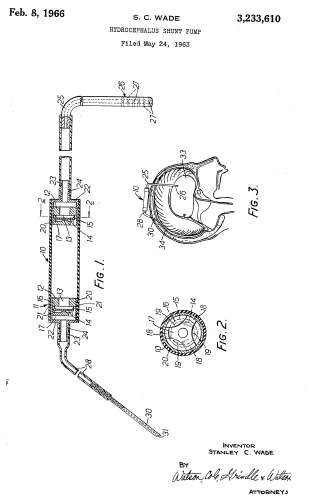Joseph deBettencourt
Chicago, Illinois, USA

the original patent application. Wade, Stanley C.
(1966) US Patent No.3233610. Retrieved from
On a cool December day in 1960, a nanny was pushing an infant in a stroller down 85th Street in New York City. Stepping into the road, the nanny saw a taxi whip around the corner and before she could react, the stroller was struck by the taxi and knocked into the side of a bus. The young ward, Theo Dahl, was rushed to the hospital where he was found to have several fractures in his skull.1 Theo, being only four months old at the time, was quite fragile and faced a long road to recovery. His care included the placement of a ventriculoperitoneal shunt because he had developed hydrocephalus from the accident. This shunt, while lifesaving, presented its own challenges. Even today, one of the main complications of ventriculoperitoneal shunts is obstruction. Obstruction of the shunt can prevent the drainage of cerebrospinal fluid, causing the intracranial pressure to rise and hydrocephalus to reoccur.2 In addition to obstruction, shunts are often associated with infection, which can be especially lethal in young children.
Theo traveled back home to London with his parents, where the family struggled with frequent trips back to the operating room every time the shunt was obstructed. Theo’s father was not satisfied with his son’s shunt. Having been a fighter pilot in World War II, he had seen his share of medical problems and experienced the deaths of family members from conditions that were later curable.3 He was determined that more could be done, and as a well-known children’s author he had some unique connections.
Roald Dahl was best known at the time for his wartime writing and his first children’s book, The Gremlin, which centered on air force folklore. Dahl had yet to write most of his best-known pieces when his son was injured. His first major success, James and the Giant Peach, was still being written. As he wrote about a young boy escaping in a large piece of stone fruit, he also began to pursue a solution for his son Theo’s shunt. He contacted his friend Stanley Wade, a hydraulic engineer, whom he had met through their shared interest in model airplanes. Wade, known for designing precision hydraulics as well as pumps for small model aircraft, agreed to assist. Together they approached his son’s neurosurgeon, Kenneth Till. Till, too, was frustrated by the emergency surgeries sometimes necessitated by the current shunt in use (the Holter shunt), as the slits of the shunt could become obstructed with cerebral debris.4 Till allowed Dahl and Wade to observe his work in the operating room to better understand the issue and then they set to work on a solution.
The new design focused on three main aspects. First, they would design the new shunt with aluminum to reduce the cost. Second, they would create a way to allow cerebrospinal fluid to flow but prevent obstruction. Finally, they would design an introducer to reduce the risk that the shunt would be damaged or obstructed during insertion. The trio designed a metal disc that created a one-way valve to replace the slits. It would open only under pressure, reducing the possibility of blockage. In addition, they created an introducer that completely covered the critical portion of the shunt, preventing damage during insertion. Designing all of the pieces from metal not only reduced cost, but also improved durability, reducing the likelihood of removal. They patented their design and called it the Wade-Dahl-Till Shunt.5 While it was never used on Dahl’s son, whose condition resolved before the patent was accepted in 1962, the Wade-Dahl-Till Shunt was used in approximately 3,000 children before improved designs replaced its use.4
While it may seem odd that a children’s author, an engineer, and a surgeon collaborated on a medical device, the history of medicine is full of amateur scientists who have changed the landscape. The first person to experimentally measure blood pressure, Stephen Hales, was a clergyman interested in physiology.6 As for pediatrics, while there are a number of physicians credited with founding the specialty in the modern era, it has been practiced as long as people have had children. Much of what was known about childhood diseases originally came from mothers, nannies, and other caregivers. While the example of the Wade-Dahl-Till Shunt is exceptional in many ways, the field of pediatrics is built on a foundation of knowledge obtained by non-medical personnel. What unifies all of these people is not the field of medicine, but a love of children.
“If you want to remember what it’s like to live in a child’s world, you’ve got to get down on your hands and knees and live like that for a week. You find you have to look up at all these bloody giants around you who are always telling you what to do and what not to do.”
– Roald Dahl7
References
- Sturrock D. Storyteller: The Authorized Biography of Roald Dahl. New York: Simon & Schuster; 2011.
- Paff M, Alexandru-Abrams D, Muhonen M, Loudon W. Ventriculoperitoneal shunt complications: A review. Interdiscip Neurosurg. 2018;13:66-70. doi:10.1016/j.inat.2018.04.004
- Dahl R, Blake Q. Boy Tales of Childhood. London: Puffin Books; 2013.
- Buis DR, Mandl ES. Roald Dahl’s contribution to neurosurgery: the Wade-Dahl-Till shunt. Acta Neurochir (Wien). 2011;153(2):429-430. doi:10.1007/s00701-010-0834-z
- Till K. A VALVE FOR THE TREATMENT OF HYDROCEPHALUS. The Lancet. 1964;283(7326):202. doi:10.1016/S0140-6736(64)92293-7
- Clark-Kennedy AE. Stephen Hales, DD, FRS. Br Med J. 1977;2(6103):1656-1658.
- Alston A, Butler C, eds. Roald Dahl. Houndmills, Basingstoke, Hampshire ; New York: Palgrave Macmillan; 2012.
JOSEPH DEBETTENCOURT is a medical student at Rush Medical College in Chicago, Illinois, with an interest in pediatrics. He attended Northwestern University where he received a BA in Theatre and Pre-Medical Studies. He has worked as a professional actor, designer, and carpenter, as well as a standardized patient, and medical researcher.
Highlighted in Frontispiece Volume 12, Issue 1 – Winter 2

Leave a Reply